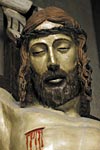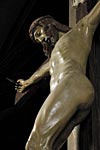Filippo Brunelleschi
(Florence 1377-1446)
Crucifix
ca. 1410-1415
wood
Florence, Municipality of Florence, Basilica of Santa Maria Novella
 It is the testimony of Filippo’s biographer,
Antonio Manetti, who also knew the artist personally,
which confirms both Brunelleschi’s autography of the
Crucifix and its original location in the right arm of
the transept of Santa Maria Novella, on the pillar
between the Strozzi Chapel and that of San Gregorio,
which later became Bardi di Vernio.
It is the testimony of Filippo’s biographer,
Antonio Manetti, who also knew the artist personally,
which confirms both Brunelleschi’s autography of the
Crucifix and its original location in the right arm of
the transept of Santa Maria Novella, on the pillar
between the Strozzi Chapel and that of San Gregorio,
which later became Bardi di Vernio.
It was not until 1503, that is to say less than a century after it had been executed, that the sculpture was requested by the Gondi family for their chapel also situated in the transept, but to the left of the main chapel where until a few months ago one could admire it before it was returned to the original location on the pillar. The well-known anecdote, according to which the Crucifix was executed by the artist to challenge the one carved by Donatello shortly before, is from a later date, becoming then a very colourful tale in Vasari’s Lives.
 The naturalness of the body sculpted by
Brunelleschi results in a sublime composure, which
derives from the noble inclination of the head, with
the locks of hair which drop like a plumb line, the
perfect curve of the eyebrows and the nose aligned
exactly with both the navel and the right big toe, but
also from the harmonious position of the arms, not too
stretched, and the knees, not excessively bent. All
this is expressed through a supreme plastic and
geometric balance.
The naturalness of the body sculpted by
Brunelleschi results in a sublime composure, which
derives from the noble inclination of the head, with
the locks of hair which drop like a plumb line, the
perfect curve of the eyebrows and the nose aligned
exactly with both the navel and the right big toe, but
also from the harmonious position of the arms, not too
stretched, and the knees, not excessively bent. All
this is expressed through a supreme plastic and
geometric balance.
 All traces of the linear style so dear to Gothic
art have vanished and, maybe, to avoid any “risk” of
curved folds, still present in the Crucifix by
Donatello, Brunelleschi did not carve a loincloth, but
instead added one (and indeed there must have been one)
in fabric soaked in plaster to accentuate the
naturalness of the composition. All the veracity of
this noble body is also derived from the study of
classical statuary, as well as from the assumed
accurate study of a true flesh-and-blood model, thus
supposing that such a practice, which in time would
become commonly used, was first employed Brunelleschi.
All traces of the linear style so dear to Gothic
art have vanished and, maybe, to avoid any “risk” of
curved folds, still present in the Crucifix by
Donatello, Brunelleschi did not carve a loincloth, but
instead added one (and indeed there must have been one)
in fabric soaked in plaster to accentuate the
naturalness of the composition. All the veracity of
this noble body is also derived from the study of
classical statuary, as well as from the assumed
accurate study of a true flesh-and-blood model, thus
supposing that such a practice, which in time would
become commonly used, was first employed Brunelleschi.
(Florence 1377-1446)
Crucifix
ca. 1410-1415
wood
Florence, Municipality of Florence, Basilica of Santa Maria Novella

It was not until 1503, that is to say less than a century after it had been executed, that the sculpture was requested by the Gondi family for their chapel also situated in the transept, but to the left of the main chapel where until a few months ago one could admire it before it was returned to the original location on the pillar. The well-known anecdote, according to which the Crucifix was executed by the artist to challenge the one carved by Donatello shortly before, is from a later date, becoming then a very colourful tale in Vasari’s Lives.

